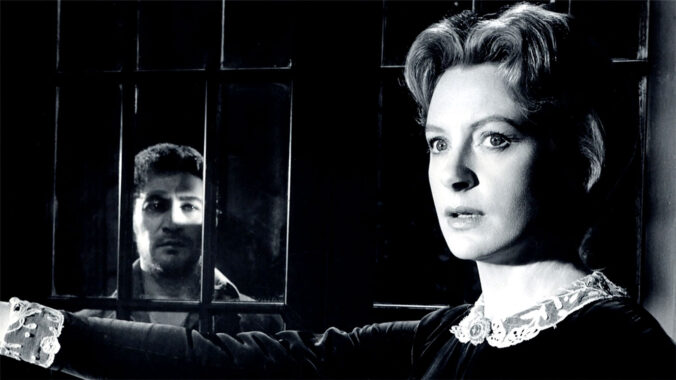Henry James’s novella The Turn of the Screw is famous for being slippery. Are the ghosts real, or is the governess losing her mind? The 1961 film The Innocents keeps that same spirit of uncertainty, but instead of James’s careful prose, it uses images, sound, and atmosphere to create doubt. The story is essentially the same, but the movie sharpens the tension, leaning into the creepy sexuality and suppressed desire that James only hinted at. Where the book makes you question every line, the film makes you question every shot.
The script started with a stage adaptation, but Truman Capote was brought in to rewrite it. His influence is evident in the sharp, suggestive dialogue and in how the children’s eerie maturity is conveyed without feeling overdone. Capote gave the film its double edge: everything can be read two ways, as either a genuine haunting or as the governess projecting her fears and repressed desires. That balancing act is what makes the movie so unsettling.
Director Jack Clayton avoids cheap scares. Instead, he lets silence and stillness work on you until a sudden figure in a window or a whisper in the dark lands like a thunderclap. His staging is deliberate: characters are positioned like pieces on a board, with distance and movement telling you just as much as the dialogue. The effect is slow-burning dread that never quite gives you release.
The black-and-white photography by Freddie Francis is breathtaking. He plays with overexposed whites, deep shadows, and reflections so that even a bright garden feels uncanny. Ghostly shapes seem to appear naturally in the frame, with no special effects needed. Wide shots capture everything in sharp focus, forcing you to wonder if that shadow in the corner is real or just your imagination. This isn’t just pretty camerawork, it’s cinematography designed to make you doubt your own eyes.
Deborah Kerr is the movie’s anchor. She plays the governess with total conviction, which is scarier than if she’d gone for hysteria. You believe she cares for the children, but her intensity makes you worry she’s also dangerous. Kerr was older than the governess in the book, which works brilliantly, as she feels like someone who has kept her emotions bottled up for years, now cracking under the strain. The final scenes wouldn’t hit nearly as hard without her layered performance.
Literary critic Tzvetan Todorov defined the “fantastic” as that moment when you can’t decide if something is supernatural or just psychological, and you’re stuck in that hesitation. The Innocents is a textbook case. Every ghost sighting can be explained naturally, and every “rational” explanation leaves room for the uncanny. The film never tips its hand, and that’s why it lingers so powerfully.
The Turn of the Screw has been filmed many times, but most versions stumble by taking too firm a stance one way or the other. Some make it a straight ghost story, others a psychological breakdown. A few are handsome productions, but none capture the same knife-edge uncertainty. The 2020 film The Turning tried but felt contrived. Probably the closest spiritual successor isn’t even an adaptation: Alejandro Amenábar’s The Others (2001), which gets the atmosphere and ambiguity right (up until the final reveal).
The Nightcomers (Michael Winner, 1972), intended as a prequel, demonstrates precisely how to ruin this kind of story. By providing us with an explicit backstory about Quint and Miss Jessel (with Marlon Brando as Quint), it explains what James and Clayton wisely left ambiguous. Instead of mystery, we get tawdry melodrama. The children’s corruption is spelled out, and the air of dread collapses into cliché. In trying to “fill in the blanks”, the movie drains away all the power of the original.
Mike Flanagan’s Netflix miniseries The Haunting of Bly Manor combines James’s story with other works of his, reframing it as a tale of love, grief, and memory. It’s beautifully acted and emotionally satisfying, but it isn’t The Innocents. Where Clayton’s film keeps you trapped in doubt, Bly Manor builds a mythology of ghosts and explains how they work. It goes for catharsis instead of unease. As a result, it’s touching but far less haunting.
Final word: The Innocents remains the gold standard. Capote’s sly script, Clayton’s restrained direction, Francis’s brilliant visuals, and Kerr’s magnetic performance combine to make a film that never gives you an answer. It’s that refusal to resolve the mystery that makes it unforgettable.
